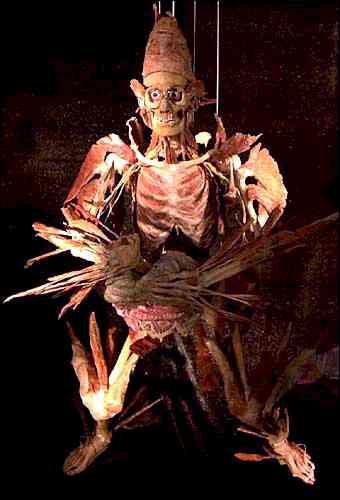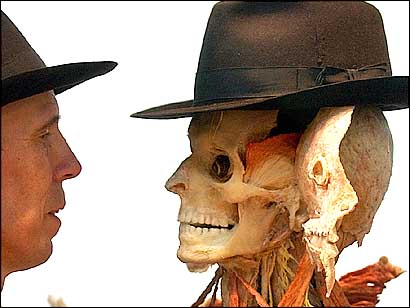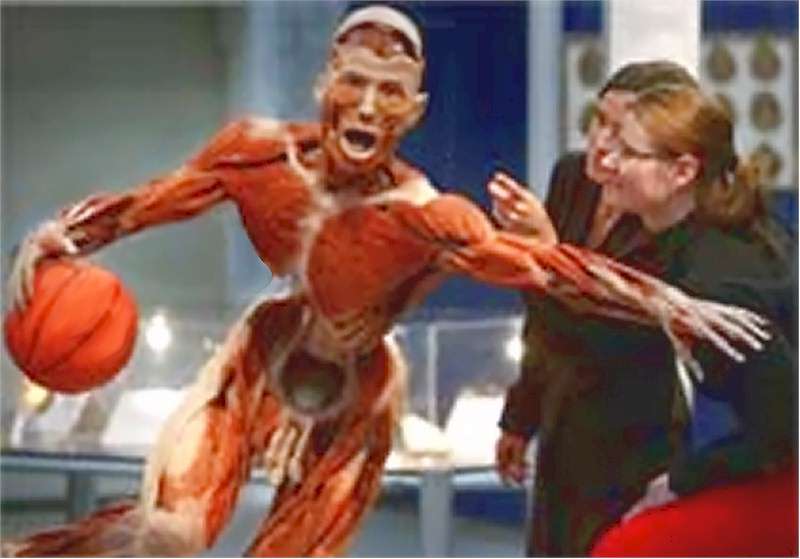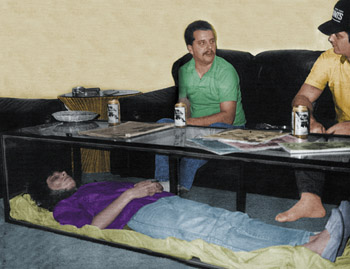Self Preservation Does NOT = Immortality
Being Dead and In a Good MoodMillions long for immortality who do not know what to do with themselves on a rainy Sunday afternoon. - Susan Ertz The only thing wrong with immortality is that it tends to go on forever. - Herb Caen by Steve Kettmann Berlin - No one who leaves a wildly popular exhibit of more than 200 well-preserved dead bodies at a converted East Berlin train station will ever look at the human form in quite the same way. And that's just the way German anatomist and inventor Gunther von Hagens wants it.
"Normally, you are only confronted with death when you lose a loved one, and it's a big shock," von Hagens said this week. "In this way you are not open-minded to thinking about death, you are just frightened. This exhibit gives people the possibility to approach death in a good mood, even a mood of festivity. It's about appreciating the body. Now the people who come in to the exhibit can develop a kind of body pride. In this way, it's about emotional anatomy. The physical aspect of death becomes visible. The physical death loses some of its fearfulness. That's the reason why we have so many body donators." All of the bodies on display in the exhibit - arrayed in various poses, including a rider on a fully plastinated horse - agreed to have their bodies preserved in this way, von Hagens says. On average, five people attending the exhibit every day sign up to have their bodies donated as well, bringing the total number who have made this commitment to 3,700. Church leaders and many others in Germany have been outraged by the "Body Worlds" exhibit, which they consider a sacrilege. But the growing success of the exhibit suggests it strikes a chord with the people. More than half a million people have shown up at the old Ostbahnhof building since the show opened 18 February, and daily attendance has actually risen, now averaging 6,000. Given the big crowds, the show was recently extended to early September - by which time it's expected to draw well over 1 million. "It's very interesting," said Holgar Blum, a hospital technician from Magdeburg who attended the exhibit on a recent balmy Berlin evening. "It's amazing to see an open body. I can see every detail." Helmut Joachim, a volleyball coach from Schwerin, brought his entire team of teenage girls to see the exhibit, and a group of several of them all said they were enjoying the exhibit very much. Nearby was a plastinated woman eight months pregnant, but the girls all said they did not find the material shocking or disturbing. "It's good to know all about how the body works," Joachim said. Even people who had qualms about putting the human body on such graphic display said they were surprised at not being taken aback to see the plastinated bodies sliced apart - in one notable case, into dozens of fragments suspended in the air like shrapnel exploding from a bomb. "I was curious whether it would bother me, but it doesn't," said Vera Neubert, a 23-year-old Berlin business student. "It's not as if it's disgusting. Not even the lungs of the smoker. It doesn't scare me. For me, it was impressive to see what modern technology can do, like one body with an artificial heart. A lot of people come just to make up their mind about it. A lot of students at my university have been talking about it." So has she made up her mind? "I'm not so sure if I like it, to be honest," said Neubert. "It's hard to imagine that these were real people, that they were alive. You just see the body, you don't know anything about who that person was." That, in a way, is von Hagen's point. He first patented the plastination procedure in 1997 at the University of Heidelberg. He hoped to stage his first plastination exhibit in Germany, but ran into considerable resistance from people who found the work merely shocking. So he staged the exhibit in Tokyo, which ended up being a big success, pulling in some 550,000 visitors. That led to similarly well attended exhibits in Mannheim, Cologne and Vienna. All told, von Hagens says, 7 million people have seen the exhibit so far. Next will be Brussels, starting in September, and early next year the exhibit is likely to move to London. Whether it makes its first appearance in the United States next year is up in the air, but von Hagens is negotiating to bring the exhibit to New York, San Francisco or Seattle - with a West Coast debut being the most likely. He considers it a good thing when visitors faint, as many have. "Formerly, about one person per day would faint," he said. "Now it's fewer than that, because more people know what's gong on. I think it's like religious fainting. They don't expect to see this beauty, and they get an aesthetic shock. They expect to see the most gruesome things, and then it's beautiful. It touches your subconscious. Then it's likely to faint." No one thronging the exhibit space during a recent visit fainted, and the emotions seemed to run from mild confusion to cheerfulness. The crowd was notably young, which has been the pattern generally. Von Hagens says the average age of those attending is 32. "The young people are interested in who we are in this technical world, and they are more interested in the whole-body plastinates, and they talk about that," he said. "The young people are still finding out who they are in this world, and in this way the exhibition goes beyond the effect of normal anatomy museums or displays." Source: wired.com 14 May 2001
Sporting Bodies Join Exhibition of the Dead
One of nine new body plastinates at the Atlantis Gallery in Brick Lane (PA) A pole vaulter and a dancer are among nine new dead bodies going on display in one of the world's most controversial exhibitions. The anatomical exhibition, "Body Worlds", features human bodies preserved using a special technique called plastination. Despite calls for the show to be banned, it has had more than 195,000 visitors since it opened in March. Now curators have installed nine new bodies, and five of them have been arranged as if they are taking part in physical activities. The bodies, which have been bequeathed to the curator of the exhibition, Professor Gunther von Hagens, include a cyclist, basketball player and goalkeeper. They will stand alongside exhibits such as a pregnant woman with her womb exposed to reveal a seven-month-old fœtus, which have been on display since the show opened. A specimen which combines the skeleton and the arterial circulation for the first time is also going on display. Prof Hagens, who invented plastination, spent a fortnight touring UK universities with one of his exhibits. "Body Worlds" is on display at The Atlantis Gallery on Brick Lane, east London, until 29 September 2002.
Professor von Hagens and friend Source: ananova.com Friday 12 July 2002
Not everyone sees the exhibit as a thing of beauty... Man Remanded on Corpse Damage ChargeA former school teacher accused of damaging a corpse with a claw hammer, causing damage estimated at £30,000, has been sent for trial. Geoffrey Lee, 50, is alleged to have attacked the preserved body of a man holding his liver last March. Entitled The Organ Donor, it was one of 25 exhibits at the Body Worlds show, staged by Gunther von Hagens, a German Professor of Anatomy, at a gallery in Brick Lane, east London. Unemployed Lee, who has also worked as a lecturer and as a computer programmer, appeared at a five-minute plea and directions hearing at London's Southwark Crown Court to deny one count of criminal damage. The charge alleges that he attacked the "human body exhibit", property of Arts and Sciences Ltd, "without lawful authority", and intending or being reckless as to whether such damage was caused. Fixing his three-day trial for the "warned list" for the week beginning 14 October, Judge Paul Dodgson told Lee, of Dove Road, Dalston, north London, that he could remain on bail on condition he did not return to the exhibition. "But maybe you don't want to go back there anyway," the judge added. Professor von Hagens preserves his donated bodies by drawing off their body fluid and replacing it with a type of plastic in a technique known as "plastination". Source: ananova.com Friday 26 July 2002
I can't help but wonder what von Hagens does with the skins he removes. I say this because I read where several people who are covered in tattoos of which they are quite proud have asked that their skins be removed and tanned so that their lovely tattoos can be preserved. I wonder, too, if plastination is the way they preserve the "here's what we serve" food displays which can be seen in glass cases in front of some airport restaurants... See also:
Maverick German Doctor Faces New Corpse Dispute
Corpse Art: Two women look at a plastinated human specimen depicting a basketball player German anatomist Gunther von Hagens, whose corpse exhibitions have drawn praise and blame, faced new controversy overnight as prosecutors said they would check claims he processed bodies of executed Chinese prisoners. Von Hagens' Heidelberg-based Institute for Plastination declined to comment on the allegations in Der Spiegel news magazine. "The accusations are heavy and broad-ranging so we need time for a proper statement," a spokeswoman said. She said Von Hagens would hold a news conference later in the week in Frankfurt, where his Body Worlds exhibition is on show. The chief public prosecutor in the southwestern city of Heidelberg, Elke O'Donoghue, said: "We will check whether an inquiry should be launched." Der Spiegel said von Hagens had a company in the northeastern Chinese port city of Dalian that purchased large quantities of corpses in China, including the bodies of execution victims, recognisable by bullet holes in the head. Von Hagens' website says he has a laboratory in China which employs 200 people, but gives no further details. He has repeatedly said all bodies used in his exhibitions are legally obtained. His show displays flayed corpses opened to show the internal organs, muscle and bone, and preserved by "plastination", a process developed by von Hagens which replaces all body fluids with polymers to create odourless, long-lasting exhibits. German judicial sources said preserving bodies without the prior consent of the deceased may constitute an offence punishable in Germany even if they were processed in China. Critics have called it a freak show, but the travelling exhibition has attracted some 13.5 million visitors across Germany and in London, Japan, Korea and Brussels since the mid-1990s. Von Hagens has faced similar accusations before. Last November, a member of parliament in Kyrgyzstan sparked outrage by alleging that the country's prisons and hospitals illegally sold off tonnes of corpses and body parts which ended up as museum exhibits in Europe. Von Hagens appeared before parliament in the Central Asian state to deny breaking any laws or using Kyrgyz bodies in his exhibitions. Source: stuff.co.nz 20 January 2004 photo credit Reuters
Museum Plans to Exhibit Decomposing Human BodyBritain's Science Museum is considering a particularly gruesome new exhibit - a decomposing human body displayed in a glass box. The planned attraction in an adults-only part of the London museum would be intended to prompt debate and tackle taboos about death, the Sunday Times said. However the museum is still consulting experts such as pathologists and bereavement counsellors to work out both practicalities and ethical concerns, and the idea could still be abandoned, the report said. The museum's head of learning told the newspaper that the exhibition, if it did go ahead, would use a real body. "It would be a body of a person who has given consent to have their body displayed as part of an exhibition about death," said Ben Gammon. "The idea is that you would see the body decomposing in a similar way to how it would decompose in the ground." A television company was also interested in filming the process through time-lapse photography, he added. - AFP Source: smh.com.au 15 March 2004
Dead Wife As a Coffee Table
Jeff Green is a 32-year-old American living in Arizona. Jeff's beloved wife recently died, causing Jeff to suffered great pain. Consequently, he did something quite unusual. He said, "I could no longer take the pain that my wife's death caused me, so I brought her back home." This is where Jeff's story has a twist. His wife Lucy had been born with a heart condition that cut off her life at the young age of 29. Her last words to Jeff had been, "We will meet again in heaven." But These words were insufficient to alleviate Jeff's despair. At the funeral, in desperation, Jeff decided that he could not let Lucy leave him. "I called the cemetery caretaker and explained my feelings. I spoke with the authorities and got special permission to take my wife home with me. They thought it was strange, but I'd rather have her at home than 6 feet underground. Lucy had a great sense of humour and I'm sure she would appreciate being my coffee table." Jeff ordered a special glass case that eliminates decomposition of the dead body. "It cost me about $6,000.00, but it was worth it." Some of his friends and relatives have stopped visiting Jeff but his true friends respect his decision and continue. Some even comment that it is a "nice piece of furniture". Source: geocities.com
Human Remains Used in Artificial ReefsOcean City, New Jersey - As if shooting a loved one's ashes into space or pressing them into artificial diamonds were not sufficiently offbeat, relatives of the deceased now can have their ashes mixed into concrete to help form ocean habitats. A Georgia company has placed about 200 of the concrete cones, called "reef balls," in the ocean, mostly along the Gulf Coast. Last week, it interred cones filled with the ashes of several people about seven miles off the shore as part of the Great Egg Reef. Don Brawley, an accomplished diver, came up with the idea of turning artificial reefs into memorials, and founded Eternal Reefs with George Frankel in 2001. "Most states with reef programs buy artificial reefs," Frankel said. "We like to think that we're buying public reef balls with private money." Burying a loved one's ashes in a reef ball can cost $1,000 to $5,000. Decatur, Georgia-based Eternal Reefs also has two models for pets, for $400 and $500. The balls have grapefruit-sized holes in them to dissipate current, and their surface is dimpled to encourage coral growth. The company got approval from the New Jersey Department of Environmental Protection to put ashes in the reef installations. The Great Egg Reef also contains decommissioned Army tanks and old tires cabled together. Relatives and friends of those interred last week said they wanted to do something more tangible with their loved ones' ashes than scattering them or leaving them on a shelf. "I thought we would get my three kids together and we would sprinkle them on the ocean," Kit Aronson, who buried the ashes of her husband, Robert, told The New York Times. "But this is doing it in a more identifiable fashion, where the kids can see where he is. Not in a mausoleum or Arlington Cemetery, but outdoors." Source: story.news.yahoo.com Sunday 26 September 2004
Going Out in Styleby Jim Hightower Time for another trip into the Far, Far, Far-Out Frontiers of Free Enterprise. Today, Spaceship Hightower transports you to a place that prepares you for the world beyond - or at least prepares your body for its eternal rest. Some people simply get buried, some are cremated and have their ashes creatively spread, but some go to Summum, a Salt Lake City religious group that can really do you up right. Associated Press reports that Summum is the one place on earth where you can be mummified. For a fee, of course. This is not your old Egyptian mummy, but an updated, high-tech process that the Summum folks have patented after having practiced on several cadavers. The corpse is cleaned and drained, soaked in a vat of "secret formula" preservation fluid for up to 6 months, covered with lanolin, and wrapped with gauze. Next, the corpse gets a dozen coats of polyurethane rubber, after which it is wrapped in layers of fiberglass bandages, which set the body in position for eternity. We're not through. The mummified body is then placed in a bronze container called a mummiform - much like those found in the ancient pyramids. The container is finally is sealed with resin and can be topped off with a paint job or gold leaf. It's then yours to be put in a mausoleum, made into a coffee table, or whatever. Mummification is not for everyone, though, for it's a pricey proposition. First, you've got to get the corpse to Salt Lake City - about a US$5,000 trip. The process itself costs some US$12,000, and your standard bronze mummiform goes for US$36,000. Tack on gold-leafing, mausoleum space, and - well, if you have to ask, you can't afford it. Already, though, 137 people have ponied up the cash to go out in style when they die - mummy style. If you like the idea, but don't have the money for mummification, Summum will do your cat for US$9,000. Source: Funny Times January 2001
2000-Year-Old Woman FoundThe corpse of a woman who died more than 2,000 years ago has been found well preserved in a mystery fluid in eastern China, state media reported today. The body of the woman, who was believed to have lived during the Western Han Dynasty (206 BC - 24 AD), still had some of her skin, muscle tissue and veins, according to the Xinhua news agency. Construction workers at a building site in Lianyungang, Jiangsu province, discovered the corpse, which was in a coffin, on 8 July, Xinhua said. "The female corpse, estimated to be over 2,000 years old, is said to still have elastic muscle tissue from being immersed in a special fluid in her coffin," Xinhua quoted Lianyungang museum curator Zhou Jinping as saying. Zhou said a rectangular lacquer box, a bamboo food container, a comb, a copper mirror and a lock of hair with a hairpin were also found in the coffin. Xinhua described the corpse as priceless, in terms of archeological research, and said it was now being preserved in formalin solution and covered with a layer of absorbent cotton. The news agency did not identify the fluid used to preserve the corpse for 2,000 years. Zhou said further investigations would be made to determine the woman's precise historical age, social status and other background details. Xinhua said the woman was only the third well-preserved Han Dynasty corpse ever discovered. The other two were excavated separately in the Mawangdui Han Tomb in Changsha, Hunan province, and the Jingzhou Han Tomb in Hubei Province. Source: news.com.au 14 July 2002 from Agence France-Presse
The "special fluid" this woman was immersed in had kept her preserved for 2,000 years. Yet she was removed from it and placed in a formalin solution and covered with cotton because - hey - that's bound to do a better job, right? Maybe they should've plastinated her...
And finally... Cremated Remains of Woman "Made into a Diamond Stone"The cremated remains of an 80-year-old woman have been presented to her family in the form of a diamond stone, the first delivery of this kind in the world. The remains of Edna MacArthur from Alberta, Canada were compressed into a three gramme sample and flown to Italy. Intense heat was then used to incorporate the remains into carbon used to craft a diamond. "This is the first presentation of a synthetic diamond made in this way," Brian Crawford, president of Edmonton-based Fountain Garden Funeral Services. The quarter carat diamond was presented to MacArthur's granddaughter, Tracey Somerville. The family planned to have the stone placed in a golden ring. The quarter carat diamond cost the family CAN$3,240 (£1,281) which Crawford said was much cheaper than the cost of a burial with a moderately priced wooden casket. Its manufacturing process took two weeks. Crawford said his company has already received three more orders, including a pre-arranged order from a living person. Source: ananova.com Tuesday 31 December 2002
Stones from Bones
"It's what they would have wanted!" For $4,000 you can now wear a loved one on your finger. The next time someone tells you that diamonds are a girl's best friend, they may not be speaking metaphorically. Those sparkling gems may really be her best friend, or her husband, or even her dog. Life Gem, a small company based near Chicago, has started offering diamonds made from the cremated remains of people and pets. Funeral homes in Illinois, Wisconsin and New York have signed up to market the service to their clients, who can literally have loved ones wrapped around their fingers for eternity. Life Gem estimates that the carbon from one cremated human body can yield up to 50 stones of varying sizes. With prices starting at $4,000 for a quarter-carat, though, it will not be cheap to add Uncle Harold to the family's jewellery collection. Although the idea may sound weird, the company insists that it is technically feasible. According to Life Gem executives, an American-owned diamond laboratory in Germany spent three years developing the process of extracting carbon from animal and human bone; turning it into precious stones is the easy bit. The lab's anonymous owner will reportedly produce stones for Life Gem until the company builds its own facility in America. It may be on to something. A growing number of Americans - about a quarter of those who died last year - are cremated. Life Gem says it is also looking to Japan, where the vast majority of people are cremated, and to the pet market for more opportunities. And if these new markets do not suffice? It could always start competing head to head with Atlanta-based Eternal Reefs, which mixes ashes with concrete and uses the blocks - a "permanent environmental tribute to life" - as coastal reef formations. Source: The Economist 24 August 2002
Visit Life Gem's website (lifegem.com) to see photos of diamonds made from the cremated remains of people and pets. The diamonds apparently are mostly yellow. See also:
For articles related to ageing, including feats that can be accomplished, and a non-spiritual look at what happens after death - funerals, jerky, popsicles, fertiliser, ashes, orbit or dust - click the
"Up" button below to take you to the Index page for this Older and Under section. |
 Animals
Animals Animation
Animation Art of Playing Cards
Art of Playing Cards Drugs
Drugs Education
Education Environment
Environment Flying
Flying History
History Humour
Humour Immigration
Immigration Info/Tech
Info/Tech Intellectual/Entertaining
Intellectual/Entertaining Lifestyles
Lifestyles Men
Men Money/Politics/Law
Money/Politics/Law New Jersey
New Jersey Odds and Oddities
Odds and Oddities Older & Under
Older & Under Photography
Photography Prisons
Prisons Relationships
Relationships Science
Science Social/Cultural
Social/Cultural Terrorism
Terrorism Wellington
Wellington Working
Working Zero Return Investment
Zero Return Investment He believes that his system of plastination - preserving the flesh of actual corpses by
removing the water and injecting polymers - helps people appreciate the natural beauty of their bodies. That means seeing just what the body looks like, minus skin and fat,
and helping to ease some of the natural fear of death and decay. Some bodies are presented as somewhat dismembered wholes, others in cross section.
He believes that his system of plastination - preserving the flesh of actual corpses by
removing the water and injecting polymers - helps people appreciate the natural beauty of their bodies. That means seeing just what the body looks like, minus skin and fat,
and helping to ease some of the natural fear of death and decay. Some bodies are presented as somewhat dismembered wholes, others in cross section.



